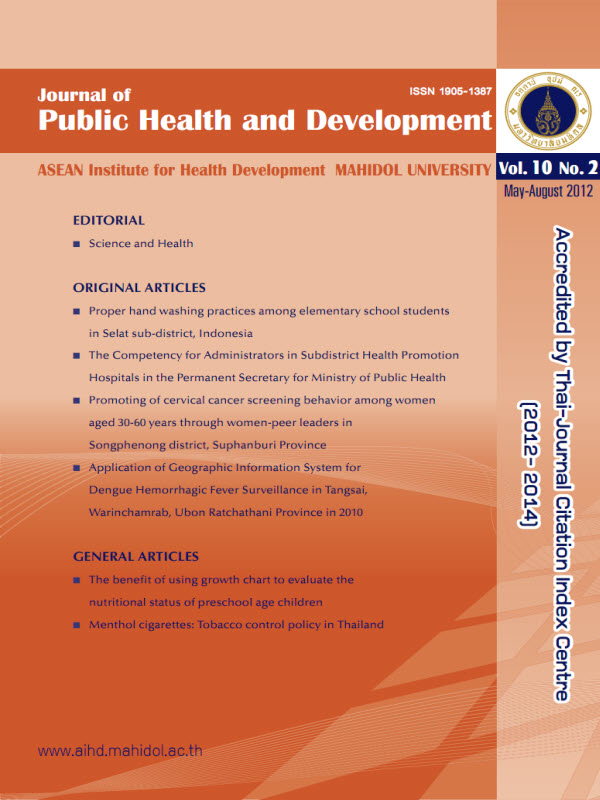Application of Geographic Information Systemfor Dengue Hemorrhagic Fever Surveillance in Tangsai, Warinchamrab, Ubon Ratchathani Province in 2010
Main Article Content
Abstract
The purposes of this research was to make use of the geographic information system (GIS) for Dengue
Hemorrhagic Fever (DHF) Surveillance. The survey was divided into 3 periods: the pre seasonal outbreak
(January-April 2010), the seasonal outbreak (May-August 2010) and the post seasonal outbreak (September-
December 2010). Larval vectors surveys of water containers both inside and outside residences were
conducted by means of a Global Positioning System (GPS). DHF indices including the house index (HI),
the container index (CI), and the breteau index (BI) were analyzed. The DHF risk areas identified via a
GIS program showed the boundary of the breeding areas of Aedes aegypti within 30 or 60 meters from the
household where larva were found.
The results showed all three periods had a moderate risk level (BI 6-49). GPS is an alternative method for
predicting mosquito breeding sites and can be used for decision-making, surveillance, and the epidemiological
control of DHF.
Hemorrhagic Fever (DHF) Surveillance. The survey was divided into 3 periods: the pre seasonal outbreak
(January-April 2010), the seasonal outbreak (May-August 2010) and the post seasonal outbreak (September-
December 2010). Larval vectors surveys of water containers both inside and outside residences were
conducted by means of a Global Positioning System (GPS). DHF indices including the house index (HI),
the container index (CI), and the breteau index (BI) were analyzed. The DHF risk areas identified via a
GIS program showed the boundary of the breeding areas of Aedes aegypti within 30 or 60 meters from the
household where larva were found.
The results showed all three periods had a moderate risk level (BI 6-49). GPS is an alternative method for
predicting mosquito breeding sites and can be used for decision-making, surveillance, and the epidemiological
control of DHF.
Article Details
How to Cite
1.
Saengnil W, Wongbutdee J. Application of Geographic Information Systemfor Dengue Hemorrhagic Fever Surveillance in Tangsai, Warinchamrab, Ubon Ratchathani Province in 2010. J Public Hlth Dev [internet]. 2012 Sep. 11 [cited 2026 Jan. 16];10(2):50. available from: https://he01.tci-thaijo.org/index.php/AIHD-MU/article/view/2646
Section
Original Articles


